John de Vere, 13th Earl of Oxford, the second son of John de Vere, 12th Earl of Oxford, and Elizabeth Howard, a first cousin of John Howard, 1st Duke of Norfolk, was one of the principal Lancastrian commanders during the English Wars of the Roses.
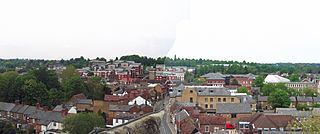
Rickmansworth is a town in southwest Hertfordshire, England, about 17 miles (27 km) northwest of central London and inside the perimeter of the M25 motorway. The town is mainly to the north of the Grand Union Canal and the River Colne. The town of Watford is 5 miles (8 km) to the northeast. Rickmansworth is the administrative seat of the Three Rivers District Council. The confluence of the River Chess and the River Gade with the Colne in Rickmansworth inspired the district's name. The enlarged Colne flows south to form a major tributary of the River Thames. The town is served by the Metropolitan line of the London Underground and Chiltern Railways from London Marylebone to Aylesbury railway station.
Dovercourt is a small seaside town and former civil parish, now in the parish of Harwich, in the Tendring district, in the county of Essex, England. It is older than its smaller but better-known neighbour, the port of Harwich, and appears in the Domesday Book of 1086. Today the towns are contiguous. In 1921 the parish had a population of 7695.

Halstead is a town and civil parish in the Braintree District of Essex, England. Its population of 11,906 in 2011 was estimated to be 12,161 in 2019. The town lies near Colchester and Sudbury, in the Colne Valley. It developed initially on the hill to the north of the river. The name Halstead is said to derive from the Old English hald and stede, meaning "healthy farm" or "place of refuge".

Stourton Caundle is a village and civil parish in the county of Dorset in southwest England. It lies within the Blackmore Vale, about five miles east of Sherborne. In the 2011 census the parish had 181 households and a population of 439.

Castle Hedingham is a village in northern Essex, England, located four miles west of Halstead and 3 miles southeast of Great Yeldham in the Colne Valley on the ancient road from Colchester, Essex, to Cambridge.

Brimpton is a mostly rural village and civil parish in West Berkshire, England. Brimpton is centred 4.5 miles (7.2 km) ESE of the town of Newbury.
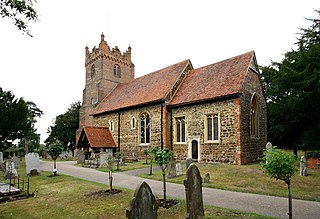
Fryerning is a small village and former civil parish, now in the parish of Ingatestone and Fryerning, which is situated approximately 1+1⁄2 miles (2.4 km) north of Ingatestone in Essex, England. The parish church of St. Mary the Virgin, on Blackmore Road, dates back from the 11th century, with a 15th-century brick tower. It has a memorial stained glass window to the murdered politician Airey Neave, which was unveiled by his cousin Penelope in 1985. An ancient English Yew, found to the west of the church and is over a millennium old, is thought to be one of Essex's oldest trees. In 1881, the parish had a population of 704.
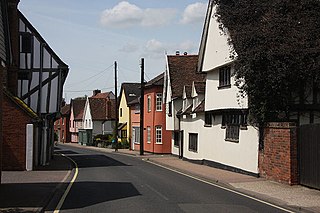
Bures is a village in eastern England that straddles the Essex/Suffolk border, made up of two civil parishes: Bures Hamlet in Essex and Bures St. Mary in Suffolk.

Hullavington is a village and civil parish in Wiltshire, England, just to the north of the M4 motorway. The village lies about 4 miles (6 km) southwest of Malmesbury and 5+1⁄2 miles (9 km) north of Chippenham.

Earls Colne is a village in Essex, England named after the River Colne, on which it stands, and the Earls of Oxford who held the manor of Earls Colne from before 1086 to 1703.

Drayton St. Leonard is a village and civil parish on the River Thame in Oxfordshire, about 8 miles (13 km) southeast of Oxford.
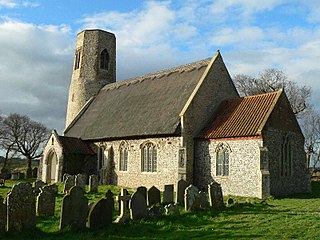
EdingthorpeEdingthorpe is a small village and former civil parish, now in the parish of Bacton, in the North Norfolk district, in the county of Norfolk, England. The village is located 10 miles (16 km) south-east of Cromer and 16 miles (26 km) north-east of Norwich. In 1931 the parish had a population of 213. On 1 April 1935 the parish was abolished and merged with Bacton under the County of Norfolk Review Order, 1935.
Colne Priory at Earls Colne, Essex was a Benedictine priory, initially a dependent cell of Abingdon Abbey, Berkshire. It was founded by Aubrey de Vere I and his wife Beatrice in or before 1111. One piece of research suggests that the original Abbot, Faritius, was appointed in 1101; he initially placed six monks at the site. Their eldest son Geoffrey had died at Abingdon about seven or eight years earlier and was buried there. On his deathbed, Geoffrey had bequeathed to Abingdon the church and lands at Kensington, Middlesex, and his parents and brothers had confirmed that grant, as had King Henry I.

Hatfield Broad Oak is a village and civil parish in the Uttlesford district of Essex, England. The village is approximately 5 miles (8 km) south-east of Bishop's Stortford. Near the church of St Mary the Virgin is former Benedictine priory Hatfield Regis Priory.
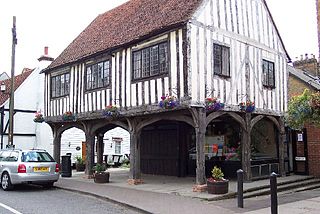
Horndon on the Hill is a village, former civil parish and Church of England parish in the unitary authority of Thurrock, in the county of Essex, England. It is located close to the A13, around one mile northwest of Stanford-le-Hope and around two miles northeast of Orsett. The village area falls within the Orsett ward of Thurrock District Council. In 2019 it had an estimated population of 1517. In 1931 the parish had a population of 1052.

Pebmarsh is a small village and a civil parish in the Braintree District, in Essex, England. It is situated to the north east of Halstead close to the A131. The population of the village is included in the civil parish of Twinstead.
Maud de Ufford, Countess of Oxford was a wealthy English noblewoman and the wife of Thomas de Vere, 8th Earl of Oxford. Her only child was Robert de Vere, 9th Earl of Oxford, the favourite of King Richard II of England. In 1404 in Essex, she took part in a conspiracy against King Henry IV of England and was sent to the Tower of London; however, she was eventually pardoned through the efforts of Queen consort Joanna of Navarre.
Katherine Mina Courtauld was a British farmer and suffragist. She was an advocate for providing training about agriculture for women. She was a member of the Courtauld family.
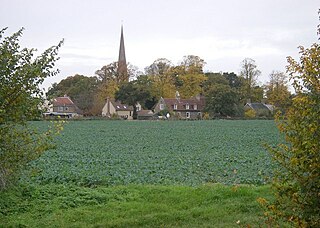
Greenstead Green and Halstead Rural is a civil parish in the Braintree district, in the county of Essex, England. The parish includes the village of Greenstead Green and the hamlet of Burton's Green, Plaistow Green and Whiteash Green. In 2011 the parish had a population of 670. The parish touches Coggeshall, Colne Engaine, Earls Colne, Gosfield, Great Maplestead, Halstead, Little Maplestead, Pebmarsh, Sible Hedingham and Stisted and surrounds the urban parish of Halstead. There are 35 listed buildings in Greenstead Green and Halstead Rural.

















